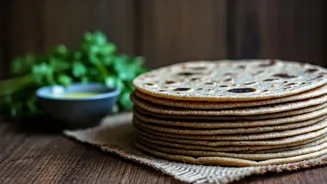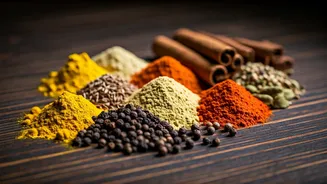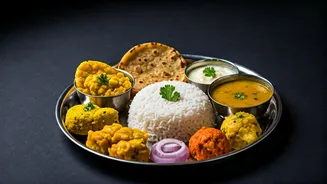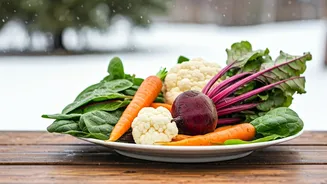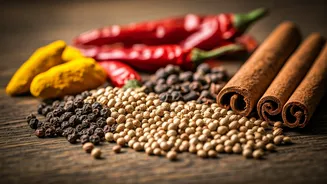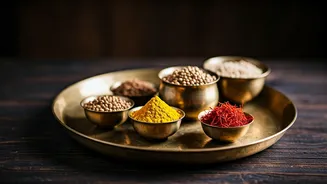Embracing Bajra Roti
Bajra Roti, often called Pearl Millet flatbread, is a cherished part of Indian cuisine, particularly during the winter months. Its popularity stems from
its inherent warmth and substantial nutritional value, making it a perfect match for the chilly season. The inherent properties of Bajra provide the body with essential warmth, helping to combat the cold. Beyond its warming qualities, Bajra Roti boasts a high fiber content, which contributes to healthy digestion. It is also a powerhouse of essential minerals such as magnesium, iron, and phosphorus. These minerals are vital for maintaining good health and overall well-being. Additionally, Bajra is gluten-free, making it a great option for those with gluten sensitivities. Bajra Roti’s versatility allows it to be enjoyed in various ways, from being a simple accompaniment to curries and dals to being paired with delicious accompaniments, creating a fulfilling meal that is both comforting and healthful. As the weather cools, a well-made Bajra Roti becomes more than just a meal; it becomes an experience, a source of comfort, and a celebration of seasonal flavors and health.
Mastering the Technique
The art of making Bajra Roti is all about the technique. Start by using high-quality Bajra flour. Mixing the flour with warm water is a crucial step. This helps in achieving the right consistency, preventing the roti from cracking. Knead the dough gently until it forms a smooth, pliable texture. Allow the dough to rest for at least 15-20 minutes, covered with a damp cloth; this relaxes the gluten and ensures soft rotis. When it comes to rolling, work gently. Use a rolling pin on a lightly dusted surface, and strive for an even thickness. The heat of the tawa or griddle must be moderate. A medium heat setting helps the roti cook evenly without burning. As the roti cooks, you will notice small bubbles forming, indicating that the roti is puffing up. Flip the roti to ensure even cooking on both sides. Once cooked, the roti should have a slightly toasted appearance. Applying ghee or butter while it's still warm adds richness and flavor. Mastering these techniques will transform your Bajra Roti from a basic staple to a culinary delight. Following these steps consistently will help to master the art of Bajra Roti making and produce a soft, perfectly cooked roti every time, turning a simple meal into a satisfying experience.
Delicious Bajra Pairings
Bajra Roti can be paired with an extensive range of dishes, ensuring that you can always explore a new combination. A classic combination is Bajra Roti with various dals like Dal Makhani or Toor Dal; the warmth of the roti complements the rich flavors of the dal. Another popular pairing is Bajra Roti with sarson ka saag and makhan, a traditional Punjabi dish perfect for winters. The earthy flavor of the saag and the richness of the makhan makes it a comforting meal. For a lighter meal, pair the roti with a simple vegetable curry or a refreshing yogurt-based raita. If you want a spicy meal, try Bajra Roti with a spicy vegetable curry or a tangy pickle. For those who like a sweeter taste, you can enjoy it with jaggery or a simple sweet dish. The versatility of Bajra Roti means that the pairings are limitless. Whether you crave a warm, comforting meal or a light, refreshing experience, Bajra Roti seamlessly blends with various flavors and cuisines. Experimenting with different pairings allows you to experience new tastes and flavors, making your Bajra Roti experience delightful.
Troubleshooting Softness
Achieving soft Bajra Rotis requires attention to detail. One common challenge is making the rotis crack or become hard. This usually happens if the dough is not mixed well. Always make sure the dough is soft and pliable; this starts with the correct ratio of flour to water. Using warm water helps with the dough's elasticity and gives softer rotis. Allowing the dough to rest is also essential; this helps relax the gluten, ensuring the rotis remain soft after cooking. When rolling the rotis, avoid rolling them too thin, which can make them dry out quickly on the tawa. Moderate heat is crucial for cooking; cooking them on high heat can make them hard. Regularly flipping the roti allows for even cooking and puffing, which are signs of a well-cooked roti. Once the roti is cooked, applying ghee or butter helps to keep it soft and adds a pleasant flavor. By focusing on these elements – dough consistency, gentle rolling, and the correct cooking process – you can easily overcome the common challenges and make soft, pliable Bajra Rotis every time. A little care and attention to these points will transform your Bajra Roti making from a challenge to an easy, satisfying experience.
